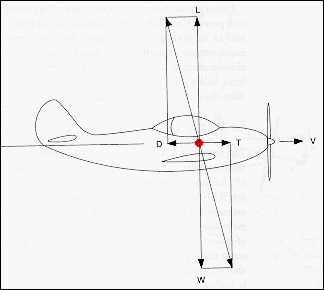| |
This
diagram shows an aircraft in level flight at a constant air-speed, V. Four forces
are shown acting on the center of mass of the plane: the weight, W = Mg,
the lift, L, the propeller thrust, T, and the drag, D.
In steady state,
that is no change in altitude or the plane's airspeed, application of Newton's
laws show that the lift force is equal to the weight, L = -W = -(mg), and the drag
force is equal to the thrust, D = -T. The diagram also shows the resultant forces from
the addition of the lift and drag force vectors, and the addition of the thrust
and weight force vectors. These resultant forces act through the center of
mass and are equal in magnitude and opposite in direction.
Power is
required to keep the 'plane flying as this is not a buoyant system. This power
must be provided by the output of the human "engine." Power is
the product of a force and a speed. For this steady state situation, the power
required is: P
= TV = DV. Typically, drag increases as V2, so that the power
required to maintain steady state flight increases as V3. Human-powered
planes will tend to be slow! |
|
|
|
|
|
|
|
|
|
|
|
|
